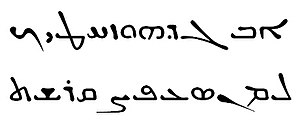East Syriac script
| Syriac alphabet |
|
|---|---|

Estrangela styled alphabet
|
|
| Type |
Impure Abjad
|
| Languages | Aramaic (Classical Syriac, Western Neo-Aramaic, Assyrian Neo-Aramaic, Chaldean Neo-Aramaic, Turoyo, Christian Palestinian Aramaic), Arabic (Garshuni), Malayalam (Suriyani Malayalam) |
|
Time period
|
c. 200 BC – present |
|
Parent systems
|
Egyptian hieroglyphs
|
|
Child systems
|
|
| Direction | Right-to-left |
| ISO 15924 |
Syrc, 135
|
|
Unicode alias
|
Syriac |
|
|
The Syriac alphabet is a writing system primarily used to write the Syriac language from the 1st century AD. It is one of the Semitic abjads descending from the Aramaic alphabet through the Palmyrene alphabet, and it shares similarities with the Phoenician, Hebrew, Arabic and the traditional Mongolian scripts.
Syriac is written from right to left in horizontal lines. It is a cursive script, but not all letters connect within a word. Spaces separate individual words.
All 22 letters are consonants, but there are optional diacritic marks to indicate vowels and other features. In addition to the sounds of the language, the letters of the Syriac alphabet can be used to represent numbers in a system similar to Hebrew and Greek numerals.
When Arabic began to be the dominant spoken language in the Fertile Crescent, texts were often written in Arabic with the Syriac script as knowledge of the Arabic alphabet was not yet widespread. Malayalam was also written with Syriac script and was called Suriyani Malayalam. Such writings are usually called Karshuni or Garshuni (ܓܪܫܘܢܝ). Garshuni is often used today by Neo-Aramaic-speakers for written communication, such as letters and fliers.
There are three major variants of the Syriac alphabet: ʾEsṭrangēlā, Maḏnḥāyā, and Serṭā.
The oldest and classical form of the alphabet is ʾEsṭrangēlā (ܐܣܛܪܢܓܠܐ; the name is thought to derive from the Greek adjective στρογγύλη [strongylē, 'rounded'], though it has also been suggested to derive from ܣܪܛܐ ܐܘܢܓܠܝܐ [serṭā ʾewwangēlāyā, 'gospel character']). Although ʾEsṭrangēlā is no longer used as the main script for writing Syriac, it has received some revival since the 10th century. It is often used in scholarly publications (such as the Leiden University version of the Peshitta), in titles, and in inscriptions. In some older manuscripts and inscriptions, it is possible for any letter to join to the left, and older Aramaic letter forms (especially of Ḥeth and the lunate Mem) are found. Vowel marks are usually not used with ʾEsṭrangēlā.
...
Wikipedia
